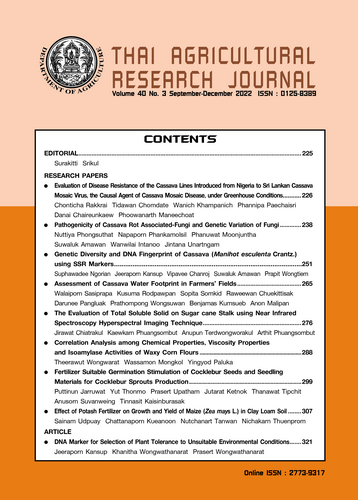Evaluation of Disease Resistance of the Cassava Lines Introduced from Nigeria to Sri Lankan cassava mosaic virus, the Causal agent of Cassava Mosaic Disease
DOI:
https://doi.org/10.14456/thaidoa-agres.2022.19Keywords:
Cassava mosaic virus, disease resistance, grafting inoculation, disease severity, virus detectionAbstract
The first outbreak of cassava mosaic disease (CMD) in Thailand was reported in 2019. The causal virus was Sri Lankan cassava mosaic virus (SLCMV). The disease destructive cassava tuber yield losses due to the introduction of the infected cutting cassava for planting across the country. To control CMD, we seek CMD-resistant cassava lines as a resistant source in plant breeding. In this research, five cassava lines resistant to CMD were introduced from Nigeria and evaluated for resistance to SLCMV under greenhouse conditions. Artificial inoculation was performed by top grafting the virus-free Nigerian cassava lines onto the SLCMV-infected shoots of CMR43-08-89, a susceptible cassava line. Disease severity and incidence were recorded 2-8 weeks after inoculation (WAI). The results revealed that all five Nigeria cassava lines, including IITA-TMS-IBA 980581, IITA-TMS-IBA 972205, IITA-TMS-IBA 980505, IITA-TMS-IBA 920057 and TME B419 were susceptible to SLCMV with 100% disease incidence. All grafted plants showed positive detection of the virus by PCR. The mean severity score of the infected cassava lines was 2.11-2.56. The control line C33 was resistant (R), while TME3 was susceptible (S). The detection of the SLCMV in both symptomatic and asymptomatic young leaves of all tested cassava lines indicated the tolerance reaction of some cassava lines.
References
จีราพร แก่นทรัพย์ สุวลักษณ์ อะมะวัลย์ ประพิศ วองเทียม อรุโณทัย ซาววา สุภาวดี ง้อเหรียญ ดนัย นาคประเสริฐ และ จิณณจาร์ หาญเศรษฐสุข. 2563 การใช้เครื่องหมายโมเลกุลในการคัดเลือกพันธุ์มันสำปะหลังต้านทานโรคใบด่าง (Cassava Mosaic Disease). ว.วิชาการเกษตร 38: 68-79.
ชูศักดิ์ จอมพุก. 2552. สถิติ: การวางแผนการทดลองและการวิเคราะห์ข้อมูลในงานวิจัยด้านพืชด้วย “R”. สำนักพิมพ์มหาวิทยาลัยเกษตรศาสตร์, กรุงเทพ. 362 หน้า.
ธิดาวรรณ ชมเดช ชลธิชา รักใคร่ ณัฎฐิมา โฆษิตเจริญกุล วานิช คำพานิช ภูวนารถ มณีโชติ ดนัย ชัยเรือนแก้ว วาสนา รุ่งสว่าง พรรณิภา เปชัยศรี และชุติมา อ้อมกิ่ง. 2563. ศึกษาวิธีการปลูกเชื้อ Sri Lankan cassava mosaic virus สาเหตุโรคใบด่างมันสำปะหลัง. หน้า 103 - 113. ใน: การประชุมวิชาการสำนักวิจัยพัฒนาการอารักขาพืช ประจำปี 2563. สำนักวิจัยพัฒนาการอารักขาพืช กรมวิชาการเกษตร กรุงเทพฯ.
ภูวนารถ มณีโชติ สุนัดดา เชาวลิต กาญจนา วาระวิชะนี วาสนา รุ่งสว่าง ภานุวัฒน์ มูลจันทะ ศิริลักษณ์ ล้านแก้ว และประภาพร แพงดา. 2558. การสำรวจและเฝ้าระวังโรคใบด่างมันสำปะหลังที่เกิดจากเชื้อไวรัส.
หน้า 2118 – 2173. ใน: รายงานผลงานวิจัยประจำปี 2558. สำนักวิจัยพัฒนาการอารักขาพืช, กรมวิชาการเกษตร.
ภูวนารถ มณีโชติ สุนัดดา เชาวลิต กาญจนา วาระวิชะนี วาสนา รุ่งสว่าง ภานุวัฒน์ มูลจันทะ ศิริลักษณ์ ล้านแก้ว และประภาพร แพงดา. 2561. การสำรวจและเฝ้าระวังโรคใบด่างมันสำปะหลังที่เกิดจากเชื้อไวรัส. รายงานผลการวิจัยเรื่องเต็ม ภายใต้โครงการเงินรายได้จากการดำเนินงานวิจัยด้านการเกษตร. กรมวิชาการเกษตร. 52 หน้า.
Akano, A.O., A.G.O. Dixon, C. Mba, E. Barrera, and M. Fregene. 2002. Genetic mapping of a dominant gene conferring resistance to cassava mosaic disease. Theor. Appl. Genet. 105: 521–525.
Alabi, O.J., P. L. Kumar and R. A. Naidu. 2011. Cassava mosaic disease: A curse to food security in Sub-Saharan Africa. Online. APSnet Features 2011-0701:1-16.
Ariyo, O.A., A.G.O. Dixon, G.I. Atiri, E.W. Gachomo and S.O. Kotchoni. 2015.Disease resistance characterisation of improved cassava genotypes to cassava mosaic disease at different ecozones. Arch. Phytopathol. Plant Prot. 48: 504-518.
Asare, P. A., I. K.A. Galyuon, E. Asare-Bediako, J.K. Sarfo and J.P. Tetteh. 2014. Phenotypic and molecular screening of cassava (Manihot esculentum Crantz) genotypes for resistance to cassava mosaic disease. J. Gen. Mol. Virol. 6: 6-18.
Beyene G., R.D. Chauhan, H. Wagaba, T. Moll, T. Alicai, D. Miano, J.C. Carrington and N.J. Taylor. 2016. Loss of CMD2-mediated resistance to cassava mosaic disease in plants regenerated through somatic embryogenesis. Mol. Plant Pathol. 17:1095-110.
Bi, H. M. A. and P. Zhang, 2010. Evaluation of cassava varieties for cassava mosaic disease resistance jointly by agro-Inoculation screening and molecular markers. Afr. J. Plant Sci 4: 330-338.
Brown, J.K., F.M. Zerbini, J. C. Navas, E. Moriones, S.R. Ramos, J.C. Silva, O.E. Fiallo, R.W. Briddon, Z. C. Hernandez, A. Idris, V.G. Malathi, D.P. Martin, B.R. Rivera, S. Ueda and A. Varsani. 2015. Revision of Begomovirus taxonomy based on pairwise sequence comparisons. Arch. Virol. 160: 1593-1619.
Egesi, C. N., F. O. Ogbe, M. Akoroda, P. Ilona, and A. Dixon. 2007. Resistance profile of improved cassava germplasm to cassava mosaic disease in Nigeria. Euphytica 155: 215-224.
Fauquet, C. and D. Fargette. 1990. African cassava mosaic virus: etiology, Epidemiology and control. Plant Dis. 74, 404–411.
Hooda, K.S., P.K. Bagaria, M. Khokhar, H. Kaur, and R. Sujay. 2018. Mass Screening Techniques for Resistance to Maize Diseases. ICAR-Indian Institute of Maize Research, PAU Campus, Ludhiana- 141004, 93 p.
Houngue, J.A., M. Zandjanakou-Tachin, H.B. Ngalle, J.S. Pita, G.H.T. Cacaïa, S.E. Ngatate, J.M. Bell, and C. Ahanhanzo. 2019. Evaluation of resistance to cassava mosaic disease in selected African cassava cultivars using combined molecular and greenhouse grafting tools. Physiol. Mol. Plant Pathol. 105: 47–53.
IITA (International Institue of Tropical Agriculture).1990. Annual Reports, IITA, Ibadan, Nigeria.
Khandare, V.B. and P. Choomsook. 2019. World trade of cavassa with special reference to Thailand. Int. J. Soc. Sci. Econ. Res. 4: 5670-5684.
Lokko, Y., E.Y. Danquah, S.K. Offei, A.G.O. Dixon and M.A. Gedil. 2005. Molecular markers associated with a new source of resistance to the cassava mosaic disease. Afr. J. Biotechnol. 4: 873-881.
Monde, G., J. Walangululu and C. Bragard. 2012. Screening cassava for resistance to cassava mosaic disease by grafting and whitefly inoculation, Arch. Phytopathol. Pflanzenschutz. 45: 2189-2201.
Okogbenin, E., C.N. Egesi, B. Olasanmi, O. Ogundapo, S. Kahya, P. Hurtado, J. Marin, O. Akinbo, C. Mba, H. Gomez, C. de Vicente, S. Baiyeri, M. Uguru, F. Ewa and M. Fregene. 2012. Molecular marker analysis and validation of resistance to cassava mosaic disease in elite cassava genotypes in Nigeria. Crop Sci. 52: 2576-2586.
Olasanmi, B., M. Kyallo and N. Yao. 2021. Marker-assisted selection complements phenotypic screening at seedling stage to identify cassava mosaic disease-resistant genotypes in African cassava populations. Sci Rep. 11, 2850.
Rwegasira, G.M. and M.E.R. Chrissie. 2015. Efficiency of non-vector methods of cassava brown streak virus transmission to susceptible cassava plants. Afr. J. Food Agr. Nut. Dev.15: 1684-5374.
Thuy, C.T.L., L.A.B. Lopez-Lavalle, N.A. Vu, N.H. Hy, P.T. Nhan, H. Ceballos, J. Newby, N.B. Tung, N.T. Hien and L.N, Tuan. 2021. Identifying new resistance to cassava mosaic disease and validating markers for the CMD2 locus. Agriculture 11: 829-844.
Downloads
Published
How to Cite
Issue
Section
License
Copyright (c) 2022 Thai Agricultural Research Journal

This work is licensed under a Creative Commons Attribution-NonCommercial-NoDerivatives 4.0 International License.
Thai Agricultural Research Journal



